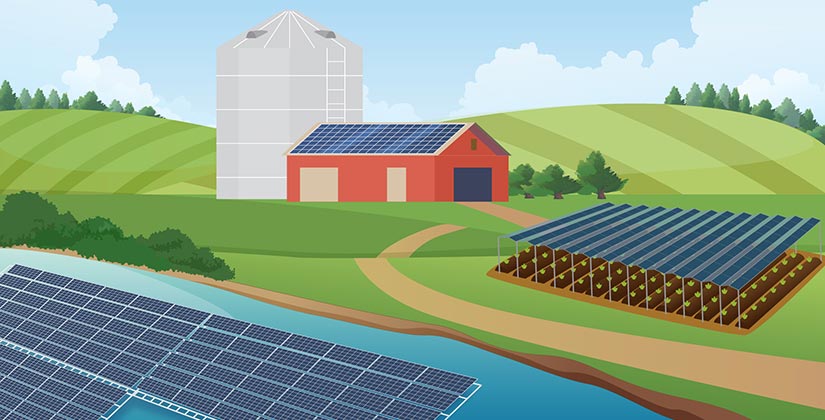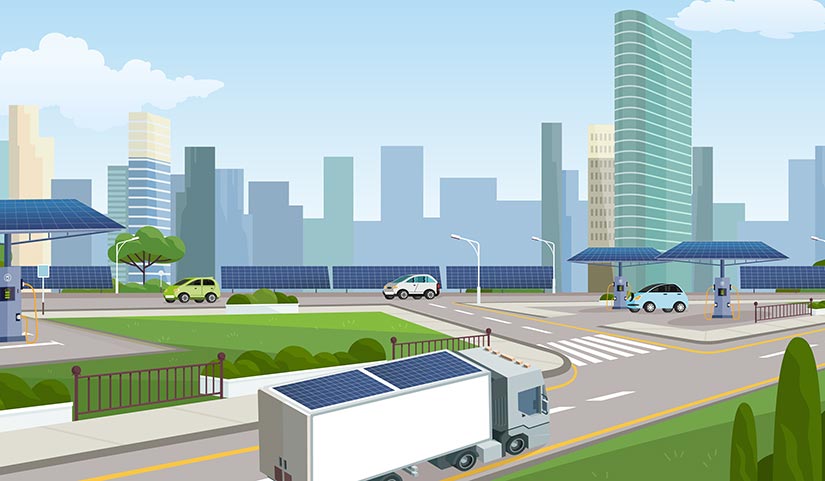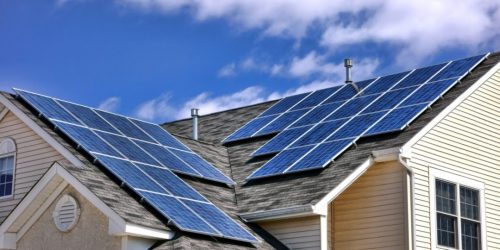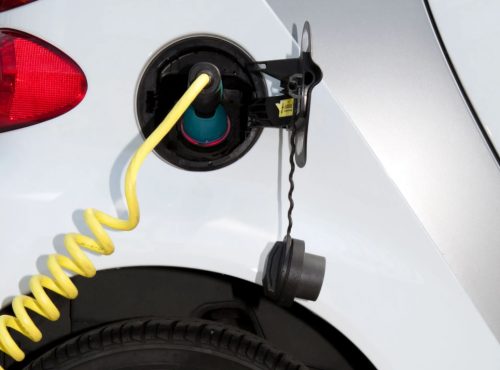The next 30 years of solar energy is likely to look very different than the past 30. Photovoltaics (PV) and concentrating solar power are likely to continue to grow rapidly—the National Renewable Energy Laboratory (NREL) projects solar energy could provide 45% of the electricity in the United States by 2050 if the energy system is fully decarbonized—and technology costs are projected to continue to decline.
But in the coming decades, the evolution of solar energy technologies could be defined more by how they interact with other energy technologies, like wind and storage. Changes across the wider energy system, like the increased electrification of buildings and vehicles, emergence of clean fuels, and new commitments to both equitability and a more circular, sustainable economy, will shape the future of solar energy. These are just some of the key findings of the Solar Futures Study, published by the U.S. Department of Energy Solar Energy Technologies Office and written by NREL. The study is based on extensive analysis and modeling conducted by NREL and synthesizes analysis across many domains to provide a balanced and rigorous assessment of the future of solar power.
“The study brought together expert perspectives across industry, government, non-governmental organizations, and universities to frame its research direction,” said NREL’s lead of the study, Robert Margolis. “Then we used several of NREL’s detailed power system modeling tools to examine how the role of solar could evolve under a set of decarbonization scenarios.”
Three Visions of the Solar Future
The study uses three scenarios: a baseline case using current policies and trends; a decarbonization scenario in which the current electric power system is 95% decarbonized by 2035 and 100% by 2050; and a decarbonization-plus-electrification scenario in which the electric grid grows significantly in scale to power the electrification of buildings, transportation, and industry. With these scenarios to set the scope, NREL researchers collaborated across sectors to determine how each scenario would play out. Their results describe a future rich with opportunities for solar integration: co-optimization with electric vehicles, solar system recycling and reuse, more equitable and widespread community adoption of solar energy, and much more.
Here we dive into the study’s cross-disciplinary approach and detail some of its specific findings by technology area and sector.
“Solar can play a synergistic role across various sectors including industry, transportation, and agriculture. To better understand the future of solar across the energy system, we brought together numerous experts from across the lab,” said NREL co-principal investigator Kristen Ardani. “We aimed to foster new collaborations and, in doing so, studied solar energy development and integration more comprehensively than ever before.”
At over 300 pages, the Solar Futures Study is definitely comprehensive but still not the full story. Seven NREL technical reports support the main study, each packed with highly detailed results from respective domains. For the curious reader, these supplemental reports dive deeper into the future of other energy technologies and sectors and their relationship to solar energy.
The Deep Dive: Solar Evolution Across Sectors
Like the overall study, a panel of industry experts shaped the scope of each detailed technical report. These reports were also framed by the same three decarbonization scenarios. NREL’s approach to collaboration added a further degree of cohesion between reports, with individual report authors also contributing to the overall study.
Each technical report drew on its own set of NREL analysis tools, but the results came together within NREL’s power grid modeling package ReEDS—the Regional Energy Deployment System. ReEDS simulates how power plants are added to and dispatched on U.S. electric grids; however, the model depends on a mix of both internal NREL data and outside data sources to estimate future demand and generation. For the Solar Futures Study, the supporting technical reports provide detailed information about the data and tools underlying the study.
The Untapped Solar Potential of Buildings
Solar energy will integrate with the buildings we live, work, and play in through two main ways: how solar systems are deployed on these buildings, and how these buildings can vary their use and storage of energy to complement solar power. Both approaches are major, largely untapped avenues of supporting decarbonization across the power grid. Today, only about 3% of solar-viable rooftops in the United States actually host PV systems. Properly operated demand-side services (energy shifting and storage) could reduce the cost of fully decarbonizing the electric grid by 22% by 2050.

Such findings emerge from NREL’s solar-building analysis in The Demand-Side Opportunity: The Roles of Distributed Solar and Building Energy Systems in a Decarbonized Grid. In the report, NREL turns its award-winning Distributed Generation Market Demand (dGen™) analysis software to each decarbonization scenario to forecast the full potential for rooftop solar deployments under different electric rate structures and PV price scenarios.
The report further explores building and neighborhood opportunities to optimize energy, such as by coordinating heating, air conditioning, electric vehicle charging, energy storage, and rooftop PV. This energy orchestration, relevant in all building types from residential to commercial and industrial, was explored using two NREL tools: Urban Renewable Building and Neighborhood optimization (URBANopt™) to model loads of representative buildings and districts, and Renewable Energy Optimization (REopt™) to find the optimal mix of renewables for each building. Apart from finding the scale of opportunity for future decarbonization, this report provides summaries of pathways and policies for buildings to serve demand-side efficiency.
Affordable and Accessible Solar for All
Solar energy expansion promises economic and resilience benefits for many communities, but without attention to how and why communities and individuals adopt solar energy, these benefits are unlikely to be shared equitably. Overcoming past inequalities in solar access has obvious benefits to local air quality, climate change mitigation, and community opportunities. In Affordable and Accessible Solar for All: Barriers, Solutions, and On-Site Adoption Potential, NREL quantifies the opportunity on both sides—for communities and for widescale decarbonization.

Once again, the dGen software proved to be a valuable tool for considering the fine-scale factors in solar energy equity. dGen is especially good at considering the different realities that different communities experience with regard to energy costs, financial credit, cultural familiarity, and other factors described in the report. dGen quantifies the missed opportunity for rooftop solar on the homes of families with low incomes, renter-occupied and multifamily buildings, and community solar deployments.
This report provides direction on how energy equity could be prioritized to achieve quicker all-around decarbonization. One major finding is that solar adoption could be 10 times greater among low- and medium-income houses if the “split-incentive problem” were solved—the problem of homeowners lacking incentives to install solar, and renters missing potential savings from installed solar. NREL addresses possible solutions to this and other problems, proposing funding programs, policies, and other provisions already in use by communities throughout the United States.
Vehicle-Solar Synergy
Electric transportation is another outsized player in the future of solar energy. The Solar Futures Study finds that solar energy could power about 14% of transportation end uses by 2050. Solar PV couples well to electric vehicle (EV) charging: Both use direct-current electricity, which avoids efficiency losses in conversion to alternating-current electricity—as much as 26% lost, in some cases. Other vehicle-solar synergies include coordinating vehicle charging with solar availability, deploying solar at parking canopies and structures, using EV batteries for second-life storage applications, and even equipping solar PV panels directly on vehicles.

“We looked at the challenges and solutions of using more solar for transportation, including some of the broader possibilities,” said Ardani, who coauthored the transportation report. “With the Solar Futures Study‘s scenarios to guide us, we performed modeling around EV market demand and electricity demand. Our results fed straight into the main study, showing the complete set of solutions available and how they shape solar growth.”
Following from its decades-long scope, the report explores technological possibilities that are waiting in the wings, like hydrogen vehicle coordination with solar-powered electrolyzers, and timed charging schemes to coordinate EV fleet charging. After establishing the size of future markets, the report considers current barriers, technology-cost constraints, and energy equity.
An Adaptable Toolkit for Energy Scenario Analysis
The Solar Futures Study considers the next several decades of solar power with greater breadth and detail than any prior solar-focused study. But the tools that made it possible are in no way exclusive to the study; they are behind many of NREL’s recent analyses of future energy systems.
With a diverse and continually validated toolkit, NREL can conduct analysis on many energy technologies and scenarios. The Interconnections Seam Study combines sector-specific forecasts into a cross-country analysis of electricity transmission capacity buildout. The Los Angeles 100% Renewable Energy Study (LA100) also uses a similar approach, providing the city with clean energy options adapted to its unique urban composition.
For even deeper analysis, NREL can combine such computational models with real power testing within the Advanced Research on Integrated Energy Systems (ARIES) platform. Plugging the results of energy scenario analysis into hardware devices can de-risk technology configurations, such as those proposed in the Solar Futures Study. Together, NREL’s capabilities for future energy analysis can help to both understand and design power systems that are technologically diverse, geographically varied, cost-effective, resilient, equitable, and clean.
“The Solar Futures Study goes beyond previous studies by examining how solar technologies will interact with the broader energy system as we pursue deep decarbonization,” said Margolis, who led the study. “The study demonstrates how NREL’s cross-disciplinary approach to modeling can provide new insights into both the challenges and opportunities we’ll encounter as solar becomes a core component of our energy system.”
Source: Connor O’Neil and Harrison Dreves, www.nrel.gov
Images Source: nrel.gov




